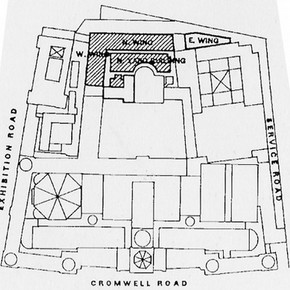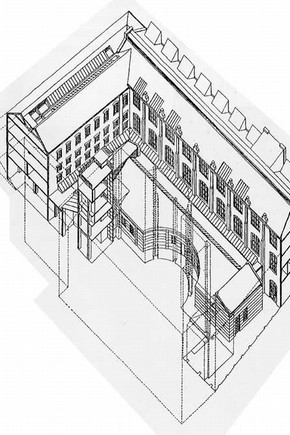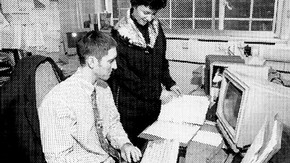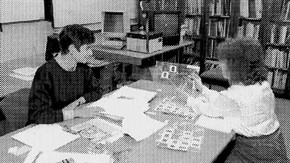Conservation Journal
October 1994 Issue 13
Carving out a role: management services
The former Conservation Administration Section became Conservation Management Services earlier this year. This change of name is I hope more than just a cosmetic change, and completes the restructuring of the Department.
Conservation is the largest Department, made up of a number of Sections, each with a different specialism. The restructuring has brought the Sections together into a smaller number of Groups and the individual Head of Groups (HoGs) are looking at ways in which their Group as a whole might benefit from the collective experiences of the separate Sections in that group. I believe that it is in this process of further co-operation and integration that Management Services will play an important role. Some functions that were formerly controlled by Administration have now been decentralised: for instance each Head of Group is now a budget holder.
At the basic level, we are retaining certain tasks such as ordering supplies, as it makes sense for us to co-ordinate the needs of the whole Department and thus to maintain reasonable but not excessive stocks of those items of equipment and materials that are used by everyone. We are currently devising ways of improving stock control which should increase overall efficiency. We act as a central point of communication between Conservation and other Departments in the Museum including the Collections, Finance and Central Services, and Buildings and Estates. Management Services are also responsible for distributing information not only through the usual channels of correspondence but also through the weekly newsletter and this Journal. The latter has enjoyed considerable success since its launch three years ago and now has a distribution in the region of 350 external to the V&A, as well as being a good tool for communicating our aims and achievements to other people within the Museum.
Unfortunately the Department suffers from a greater demand for work than it can realistically, in the present climate, hope to satisfy. Therefore we are constantly looking at ways of being able to provide a better service by being more effective and efficient in the way we plan our work. It is here that I hope Management Services can play its chief role. The HoGs are currently investigating ways of project planning and negotiating with the Collections. Management Services is involved in such tasks as trying to establish a mechanism for estimating the length of time a proposed project - for an outside loan, an exhibition on-site, or a new gallery - might take. We will then be able to allocate periods of time to such projects and to other important functions within the Department, such as teaching students and research. We are now thinking about how to treat regular work. It will be the task of Management Services to schedule all these projects to make maximum use of available resources.
One of the major events in next year's calendar is the move into the new Centre of Research and Conservation. Management Services will be involved in co-ordinating the move and in trying to ease the path for the other groups. At the moment the Department occupies several different locations and it is felt that greater co-ordination will be achieved when we are all brought together. We will probably be among the first of the Sections to move so that we are ready to receive others into the new building and able to provide support during the inevitable disruption.
But perhaps the most important change for us is the introduction of the updated version of our computer database system known as COLA (Conservation On-Line Administration) which handles requisitions for conservation. The first version (COLA1) was introduced in 1990, and I have joined the Department at the closing stages of the testing of the update. The most obvious change is that the new system will be net-worked, so that, whereas before all information was entered and held in Management Services, the new system will allow conservators who are actually working on the objects direct access to information about those objects. The emphasis this time is much more on output: COLA2 is not merely to be a record-keeping system (important though that is) on work done on specific objects, but we hope a means of enabling conservators to plan and manage their work to a greater extent through reports. It also contains a new set of screens which will hold information about treatments. The final testing and bug fixing is well under way and we hope to start training and implementing the system in the Sections in the Spring. However COLA is only one aspect of documentation which is an important part of our role.

Fig.2. Location plan of the development, showing the North Wing, West Wing and North Yard building. Austin-Smith: Lord (click image for larger version)
Many changes are going on throughout the Museum with the introduction of new IT systems such as the Collections Information System (CIS), and it is up to us to make sure we consult as widely as possible. Eventually it is hoped that our systems will link with the others to enable electronic transmission of data from one to another. At the moment paper records are still deemed to be essential and it is therefore an important task for us to try to improve and simplify forms wherever possible. A number of these forms are used as the basis of transactions between one part of the Museum and another, and it it therefore important that they are as quick to complete and as easy to understand as possible. A suite of forms responding to the needs of the multi-venue Hankyu loan to Japan was introduced by my predecessor and sets an agreed basis to be built on as changes occur. As time goes on it is envisaged that more and more of the information on these forms will be computer-generated thus saving time. Then there are such basic needs as retrieval of information, and again we should have a role in co-ordinating sytems to allow as much information as possible to be widely available throughout the Department. This will become a possibility when we are all in the new accommodation and all on the Network.

Fig.1. Axonometric of the new Centre for Research and Conservation for the Decorative Arts. Austin-Smith: Lord (click image for larger version)
The section consists of four people. The executive officer (Ian Shaw occupied this position up to October 1994) has responsibility for ordering and processing invoices and for keeping local records of expenditure to enable the HoGs to manage their budgets. He/she is also the Health and Safety liaison officer and Network Administrator, providing the first port of call with computer problems. Erica Grohmann, the administrative officer, is responsible for editorial and production work on the Journal, also has a role in ordering and is the main person who has been involved with COLA. Kathy Jenkins is the typist: she provides typing and filing services for the whole Department and provides a message service when conservators are out of their studios. She currently enters the requisitions for work onto the COLA system, but as this is gradually handed over her role will be in coaching conservators to use the system. Every one will be involved in the training of staff to use the new system. As the Head of Management Services, I oversee all of the above and work with the HoGs on policy formation.
The key in all that we do seems to me to be devising sensible mechanisms that allow the conservators to get on with conservation, and avoiding duplication of tasks by being able to take the overview of what the Department is about. In most cases this does not simply imply doing the tasks for other people; sometimes it may mean helping them devise a more efficient way of doing it them-selves. I believe that this is the aim of COLA 2. The role of the service provider is currently being much discussed within organisations such as ours. We are a Section providing a service within a Department which in turn provides a service (perhaps in an organisation which itself provides a service). Carving out a role for ourselves which makes us more proactive, and yet allows us to react to situations as they arise; striking the balance between the two; and working with a group of professionals are issues that we are not alone in facing. It will certainly provide us with an interesting challenge.

